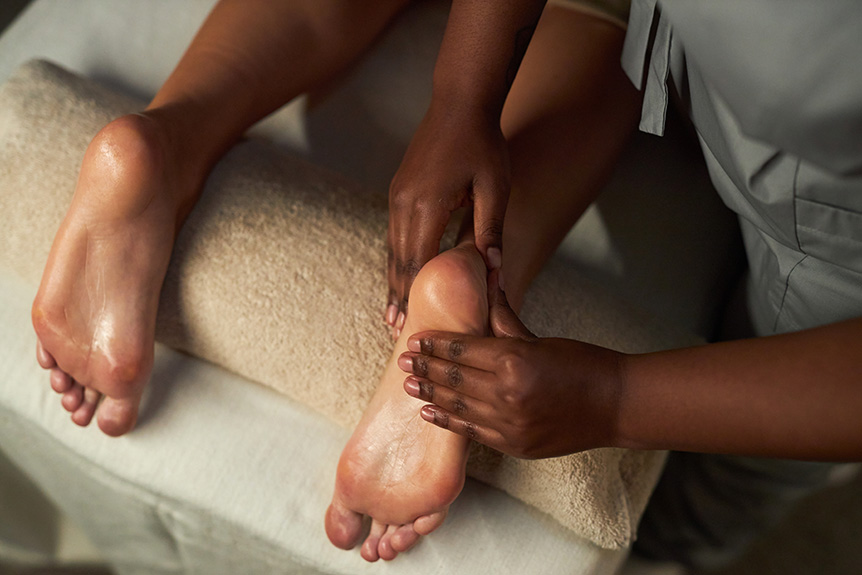It rarely causes illness, but some individuals may experience mild, temporary symptoms post-treatment such as fatigue, headache, or nausea. These reactions, often called a “healing crisis,” reflect the body’s physiological adjustments and return to homeostasis. Typically, symptoms subside within one to two days and do not indicate true sickness or harm to the body. Sensitive clients, older adults, or those with chronic health conditions may notice stronger effects. Further information clarifies safety, duration, and appropriate aftercare.
Understanding Reflexology and Its Principles

How does it work to influence overall health? It is a complementary therapy based on the concept that specific points on the feet, hands, and ears correspond to organs and systems throughout the body. Practitioners, such as those at Spa & Massage, apply targeted pressure to these reflex zones, aiming to stimulate the body’s innate healing mechanisms. The underlying theory suggests that activating these points may enhance neural pathways, promote homeostasis, and support physiological balance. It is not intended to diagnose or treat specific diseases but is often used to encourage relaxation and reduce perceived stress. Current clinical evidence indicates that it may have physiological effects, including modulation of autonomic nervous system activity. At Spa & Massage, therapists integrate these principles to support clients’ overall sense of well-being. Many people turn to this therapy to discover the healing power it offers through relaxation and balance.
Common Reactions After a Massage Session
Following a session, individuals may experience a range of physiological and psychological responses commonly referred to as post-treatment reactions.
Clinically observed reactions include mild fatigue, increased thirst, temporary headache, or transient emotional shifts. These responses are thought to result from enhanced circulation, nervous system modulation, and the body’s adaptive processes following manual stimulation of reflex points.
Some clients at Spa & Massage report subtle gastrointestinal changes, such as increased bowel movements or mild nausea, which typically resolve within 24 hours.
Skin sensitivity or warmth in the feet and hands may also occur.
Therapists at Spa & Massage recommend post-session hydration and rest to support homeostasis. These reactions are not indicative of illness but are recognized as the body’s natural adjustment to therapeutic input.
What Is the “Healing Crisis” in Zone Therapy?
The “healing crisis” in zone therapy refers to a set of temporary symptoms, such as mild fatigue, headache, or increased urination, that may occur following treatment.
These responses are considered by some practitioners to be the body’s natural process of adjusting and rebalancing after massage stimulation.
Spa & Massage therapists inform clients that such effects are typically transient and indicate the body’s adaptive reaction to therapeutic intervention.
Temporary Symptoms Explained
Occasionally, individuals may experience temporary symptoms after a massage session, a phenomenon often referred to as a “healing crisis.” This response is characterized by short-lived reactions such as mild fatigue, increased urination, headache, or changes in sleep patterns, which typically resolve within 24 to 48 hours.
From a clinical perspective, these transient manifestations are thought to reflect physiological adjustments as the body responds to therapeutic stimulation of reflex points. In the professional setting at Spa & Massage, therapists inform clients about these possibilities and recommend staying hydrated and resting as needed.
Such symptoms are generally mild and self-limiting, and are not considered adverse effects but rather part of the body’s adaptive process. Monitoring these responses can help individuals better understand their unique reactions to zone therapy.
Body’s Natural Response
Clients who notice short-term symptoms after zone therapy often inquire about the underlying physiological mechanisms. In clinical practice at Spa & Massage, these responses are sometimes described as a “healing crisis,” referring to the body’s natural attempt to restore homeostasis.
It is thought to stimulate neural pathways and enhance circulation, potentially accelerating metabolic waste elimination. This transient period may manifest as fatigue, mild headaches, or changes in bowel function.
Such symptoms are generally self-limiting, indicating the body’s adaptive processes rather than adverse reactions. Spa & Massage therapists monitor clients’ progress, offering guidance on hydration and rest to support recovery.
While these effects may feel unfamiliar, they are typically short-lived and reflect the body’s natural capacity for adjustment and self-regulation following therapeutic intervention.
Potential Side Effects and Why They Occur

It may produce transient side effects such as mild fatigue, headache, or increased urination, which are commonly reported following treatment.
These responses are thought to be associated with physiological adjustments and the body’s process of eliminating metabolic waste, sometimes referred to as detox symptoms.
Understanding these reactions helps clients recognize what is within the expected range of post-session experiences.
Common Zone Therapy Reactions
While it is widely regarded as a safe and non-invasive therapy, some individuals may experience mild and temporary reactions following treatment. These commonly reported responses include transient fatigue, light headache, slight nausea, increased urination, or emotional sensitivity.
Clinically, such reactions are considered normal and are thought to be a physiological response as the body adapts to the stimulation of reflex points.
At Spa & Massage, therapists emphasize that these effects are typically short-lived, subsiding within a few hours to a day.
The reactions may be influenced by individual sensitivity, hydration status, and overall health.
Practitioners at Spa & Massage monitor clients’ comfort closely, encourage open communication, and recommend rest and adequate water intake to support the body’s natural adjustment process after massage sessions.
Understanding Detox Symptoms
As the body responds to targeted stimulation of reflex points, transient detox symptoms may arise, including mild headache, increased thirst, fatigue, or changes in bowel and urinary patterns.
These effects are generally considered a normal physiological response, reflecting the body’s efforts to process metabolic byproducts mobilized during zone therapy.
At Spa & Massage, therapists observe that such symptoms are typically mild and self-limiting, resolving within 24-48 hours post-session.
The proposed mechanism involves enhanced lymphatic circulation and improved microvascular flow, supporting the elimination of cellular waste.
Clients are encouraged to hydrate adequately and rest following treatment to facilitate recovery.
How Long Do Post-Zone Therapy Symptoms Last?
Following a massage session, it is common for individuals to experience mild symptoms such as increased urination, slight fatigue, or temporary sensitivity in the treated areas.
Clinical observations indicate that these post-massage responses are transient, typically subsiding within 24 to 48 hours.
The physiological explanation involves stimulation of the autonomic nervous system and enhanced circulation, which may prompt the body’s natural detoxification processes.
At Spa & Massage, therapists advise clients to rest, hydrate adequately, and monitor their well-being during this period.
Most clients report a return to baseline comfort within two days, with some experiencing a heightened sense of relaxation and clarity as symptoms resolve.
Persistent or severe symptoms are uncommon and should prompt further consultation with a qualified health professional.
Who Might Be More Sensitive to this Therapy?
Individual responses to this therapy vary, with some clients exhibiting heightened sensitivity to the treatment. Clinical observations indicate that individuals with underlying chronic conditions, such as autoimmune disorders, diabetes, or circulatory issues, may be more susceptible to pronounced post-session effects.
Similarly, those new to this therapy or possessing heightened physiological sensitivity—such as individuals experiencing high stress, anxiety, or fatigue—may notice transient discomfort or intensified sensations following treatment.
Age can also play a role, with older adults and pregnant clients sometimes reacting more acutely to pressure point stimulation.
At Spa & Massage, therapists conduct detailed health assessments before each session, ensuring a clear understanding of each client’s unique medical history and sensitivity profile. This approach allows for tailored massage experiences, promoting both safety and well-being in every session.
Steps Our Therapists Take to Minimise Discomfort

Prioritising client comfort, Spa & Massage therapists implement a series of clinically informed measures to reduce discomfort during massagesessions. Each treatment begins with a detailed consultation, enabling therapists to assess individual sensitivities, medical history, and preferred pressure levels.
During the session, therapists employ gradual palpation and calibrated pressure, adjusting techniques in real time based on verbal and non-verbal client feedback.
The use of hypoallergenic oils and sanitised linens further supports a hygienic, soothing environment.
Therapists maintain open communication, encouraging clients to express any discomfort immediately, ensuring swift modifications.
Aftercare Tips to Support Your Wellbeing
Ensuring ideal therapeutic outcomes extends beyond the massage session itself, encompassing structured aftercare practices that promote ongoing physiological and psychological wellbeing.
At Spa & Massage, therapists advise clients to maintain *maximum* hydration post-session to support metabolic processes and aid the elimination of potential metabolic byproducts released during treatment.
Gentle movement, such as light walking, is recommended to facilitate circulatory and lymphatic function. Rest is equally important, allowing the parasympathetic nervous system to consolidate therapeutic benefits.
Clients are encouraged to monitor their responses—such as transient fatigue or emotional shifts—which can be normal following zone therapy.
Avoiding alcohol and heavy meals immediately after treatment helps reduce unnecessary metabolic load.
Adhering to these evidence-informed practices supports the body’s natural recovery mechanisms, reinforcing the holistic care philosophy central to Spa & Massage.
When to Seek Medical Advice After Zone Therapy
A session is generally considered safe when provided by qualified therapists, such as those at Spa & Massage. However, certain post-treatment responses may necessitate medical consultation.
Most individuals experience only mild, transient effects—such as fatigue or slight discomfort—but persistent or severe symptoms should not be ignored.
Indicators warranting prompt medical advice include intense or prolonged pain, swelling, dizziness, shortness of breath, chest pain, or allergic reactions (e.g., skin rash, difficulty breathing).
Additionally, clients with underlying health conditions (such as diabetes, circulatory disorders, or immunosuppression) should seek medical guidance if unusual symptoms arise post-session.
Spa & Massage prioritises client safety and encourages open communication with healthcare providers if concerns develop, ensuring a supportive environment that integrates both professional reflexology and medical expertise.
Conclusion
It may elicit transient, mild symptoms as the body adapts—manifesting as fatigue, headache, or digestive changes. These responses are generally self-limiting, predictable, and manageable with appropriate aftercare. For most, it supports relaxation, enhances wellbeing, and promotes physiological balance. However, for a minority, side effects may occur, persist, or intensify. Monitoring symptoms, communicating with qualified therapists, and seeking medical advice when necessary guarantees that zone therapy remains a safe, supportive, and beneficial modality within a holistic care plan.



